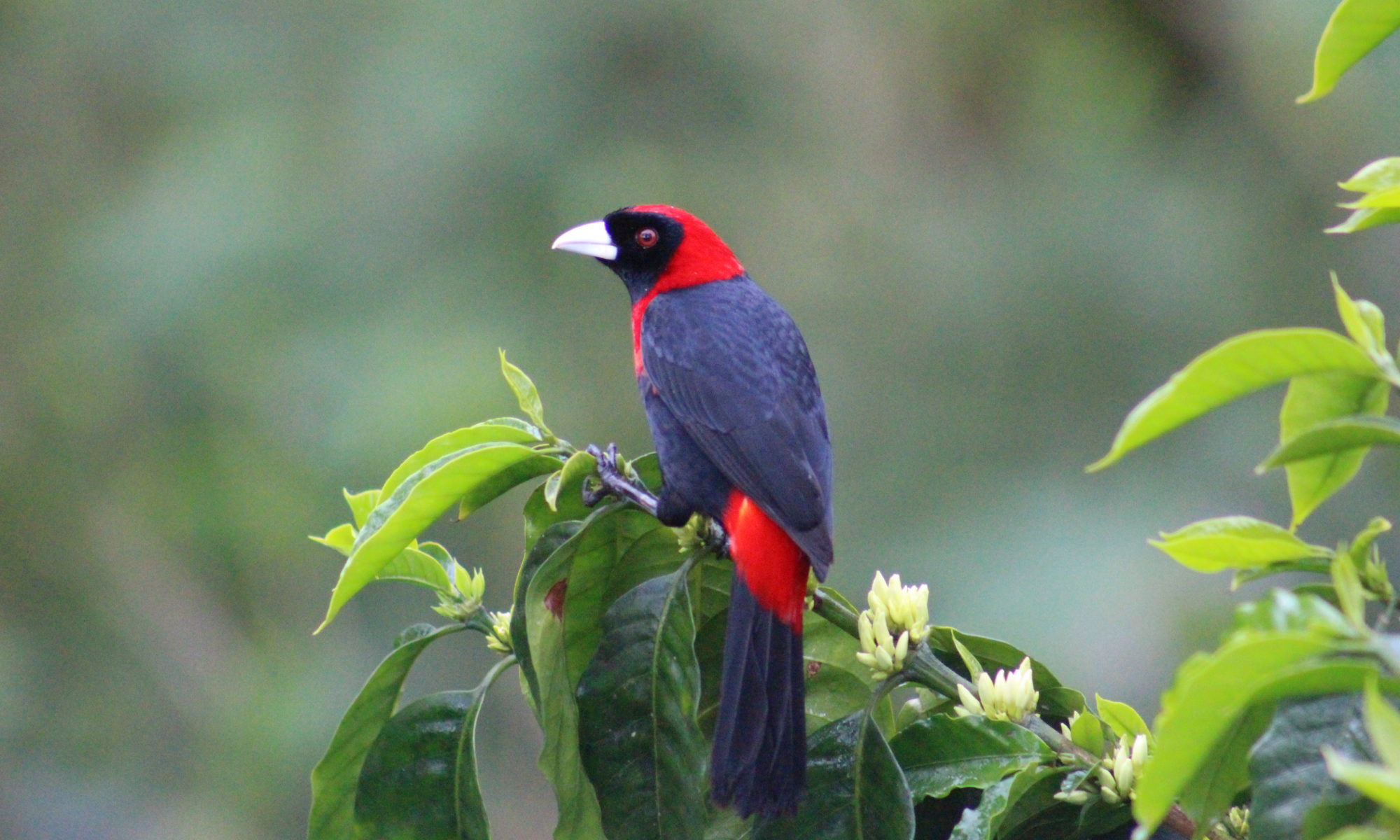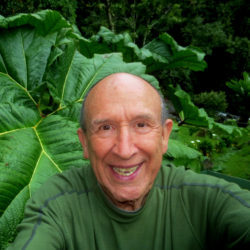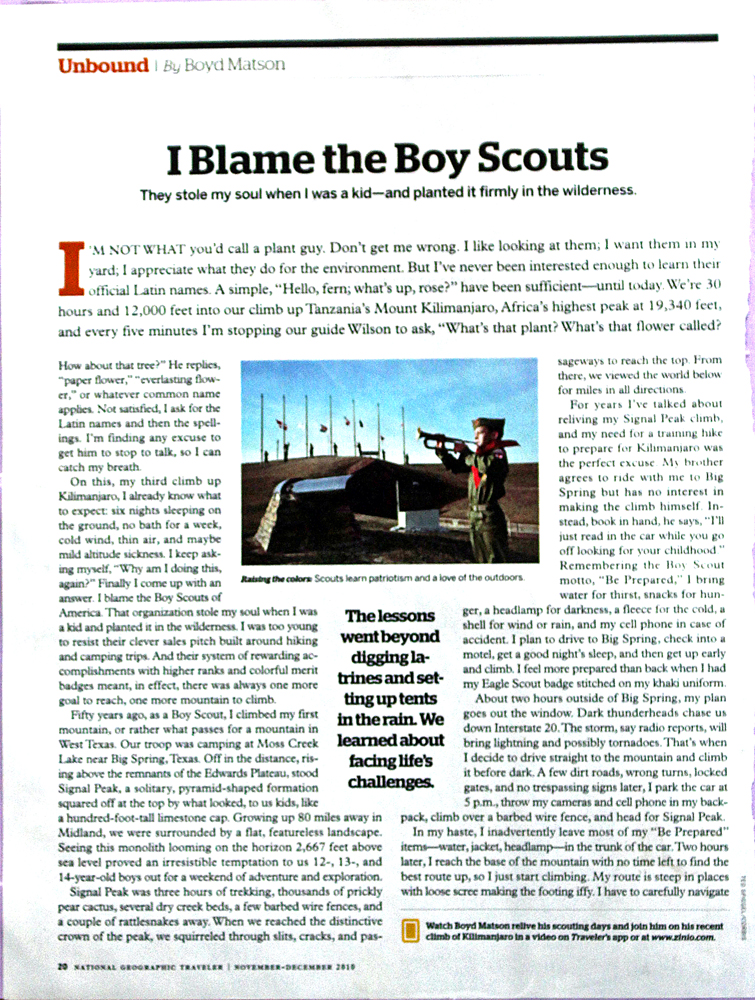This article expresses some of my sentiments on Boy Scouts, though I am nothing like Boy Matson nor have I had the grand experiences he had – yet, like him, Boy Scouts got me started on a life of adventure that I continue into my last days as a retiree in Costa Rica!
I Blame the Boy Scouts
BY BOYD MATSON, PUBLISHED OCTOBER 20, 2010 • 8 MIN READ
From the November/December 2010 issue of National Geographic Traveler
I’m not what you’d call a plant guy. Don’t get me wrong. I like looking at them; I want them in my yard; I appreciate what they do for the environment. But I’ve never been interested enough to learn their official Latin names. A simple, “Hello, fern; what’s up, rose?” have been sufficient—until today. We’re 30 hours and 12,000 feet into our climb up Tanzania’s Mount Kilimanjaro, Africa’s highest peak at 19,340 feet, and every five minutes I’m stopping our guide Wilson to ask, “What’s that plant? What’s that flower called? How about that tree?” He replies, “paper flower,” “everlasting flower,” or whatever common name applies. Not satisfied, I ask for the Latin names and then the spellings. I’m finding any excuse to get him to stop to talk, so I can catch my breath.
On this, my third climb up Kilimanjaro, I already know what to expect: six nights sleeping on the ground, no bath for a week, cold wind, thin air, and maybe mild altitude sickness. I keep asking myself, “Why am I doing this, again?” Finally I come up with an answer. I blame the Boy Scouts of America. That organization stole my soul when I was a kid and planted it in the wilderness. I was too young to resist their clever sales pitch built around hiking and camping trips. And their system of rewarding accomplishments with higher ranks and colorful merit badges meant, in effect, there was always one more goal to reach, one more mountain to climb.
Fifty years ago, as a Boy Scout, I climbed my first mountain, or rather what passes for a mountain in West Texas. Our troop was camping at Moss Creek Lake near Big Spring, Texas. Off in the distance, rising above the remnants of the Edwards Plateau, stood Signal Peak, a solitary, pyramid-shaped formation squared off at the top by what looked, to us kids, like a hundred-foot-tall limestone cap. Growing up 80 miles away in Midland, we were surrounded by a flat, featureless landscape. Seeing this monolith looming on the horizon 2,667 feet above sea level proved an irresistible temptation to us 12-, 13-, and 14-year-old boys out for a weekend of adventure and exploration.
Signal Peak was three hours of trekking, thousands of prickly pear cactus, several dry creek beds, a few barbed wire fences, and a couple of rattlesnakes away. When we reached the distinctive crown of the peak, we squirreled through slits, cracks, and passageways to reach the top. From there, we viewed the world below for miles in all directions.
For years I’ve talked about reliving my Signal Peak climb, and my need for a training hike to prepare for Kilimanjaro was the perfect excuse. My brother agrees to ride with me to Big Spring but has no interest in making the climb himself. Instead, book in hand, he says, “I’ll just read in the car while you go off looking for your childhood.” Remembering the Boy Scout motto, “Be Prepared,” I bring water for thirst, snacks for hunger, a headlamp for darkness, a fleece for the cold, a shell for wind or rain, and my cell phone in case of accident. I plan to drive to Big Spring, check into a motel, get a good night’s sleep, and then get up early and climb. I feel more prepared than back when I had my Eagle Scout badge stitched on my khaki uniform.
About two hours outside of Big Spring, my plan goes out the window. Dark thunderheads chase us down Interstate 20. The storm, say radio reports, will bring lightning and possibly tornadoes. That’s when I decide to drive straight to the mountain and climb it before dark. A few dirt roads, wrong turns, locked gates, and no trespassing signs later, I park the car at 5 p.m., throw my cameras and cell phone in my backpack, climb over a barbed wire fence, and head for Signal Peak.
In my haste, I inadvertently leave most of my “Be Prepared” items—water, jacket, headlamp—in the trunk of the car. Two hours later, I reach the base of the mountain with no time left to find the best route up, so I just start climbing. My route is steep in places with loose scree making the footing iffy. I have to carefully navigate several vertical rock outcroppings. Instead of adult eyes diminishing my childhood memories, I’m thinking: “We did this as kids?” As I near the base of the big rocky cap, the sun is setting, and I remember another lesson learned as a Boy Scout: “All successful adventures are round trips.” I use the last rays of sunlight to safely descend the mountain, missing the summit.https://9c209931a3ee3a78d28b76c38eb91a79.safeframe.googlesyndication.com/safeframe/1-0-37/html/container.html
The next morning, the storm having blown through, I try again, this time finding a better way up. Standing on the top, I think back over the past 50 years and reflect on how the Boy Scouts taught us to embrace the unknown, to test our limits, to push beyond the easy. The lessons went beyond climbing mountains, digging latrines, cooking over a campfire, or securing a tent in howling sandstorms or pouring rain, all of which we did. Instead, the outdoors was our classroom for life lessons about facing challenges and learning that the best rewards sometimes require a little pain and suffering.NAT GEO EXPEDITIONSBook your next trip with Peace of MindSEARCH TRIPS
Kids spending their lives in front of computer screens may be missing those lessons. Does a virtual world prepare them to handle adversity that has real life consequences? That’s another reason I’m back on Kilimanjaro. I’m climbing with my 20-year-old son, Taylor. At 15,100 feet in our final camp before the summit push, he’s feeling ill and questioning why I brought him. I answer, “For a father-son bonding experience.” He says, “Next time invite me to the movies.” What I don’t say is that I want him to experience the thrill of accomplishing something difficult. The final eight hours and 4,000 feet to the summit are just that kind of test for Taylor. Headache and nausea make the slog extra slow and torturous for him. I’m sure he’s contemplating turning back with every step, thinking: “This is something my dad likes. Who cares if I quit?”
But near the top I sense a change in attitude, a quickened pace, a new determination to finish no matter what. And when we are finally standing on the roof of Africa, I see in his smile that he is proud of his accomplishment. In fact, he’s so hyped about what he’s just done that he literally runs all the way, all 19 miles, back down the mountain. Although I’m equally elated, my own return, on old worn-out knees, is considerably slower. I use the time to again reflect on how I got here and thank the Boy Scouts for getting me up that first hill in Texas 50 years ago.

Be Prepared!
¡Pura Vida!


